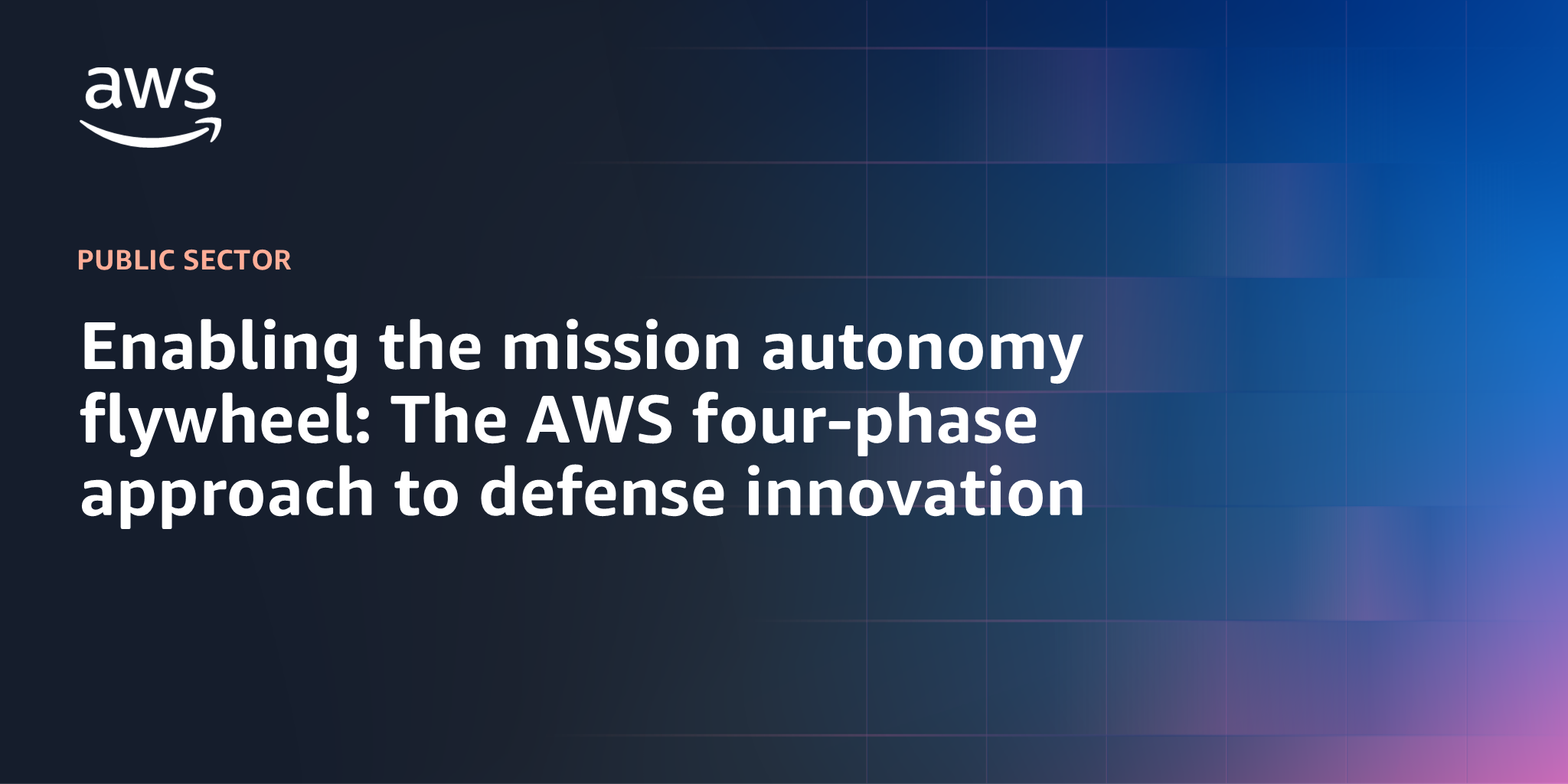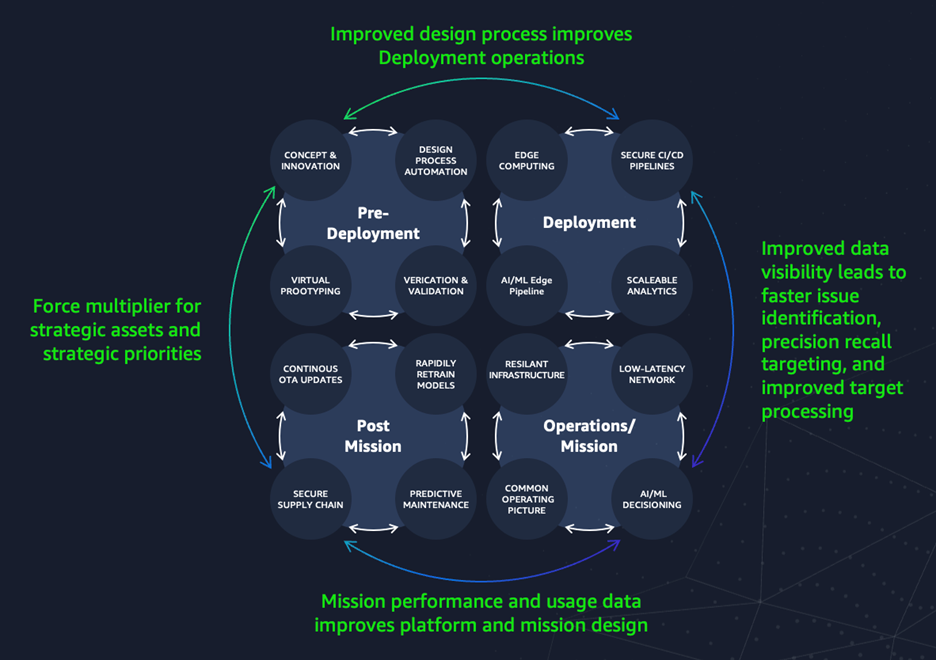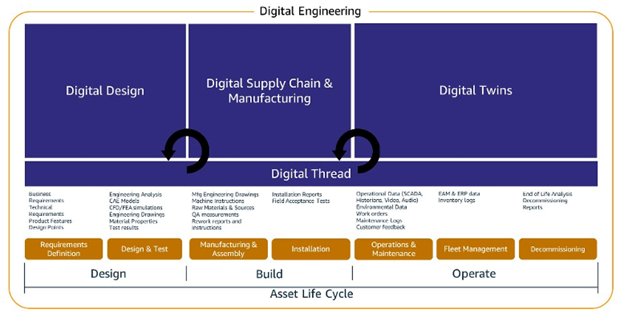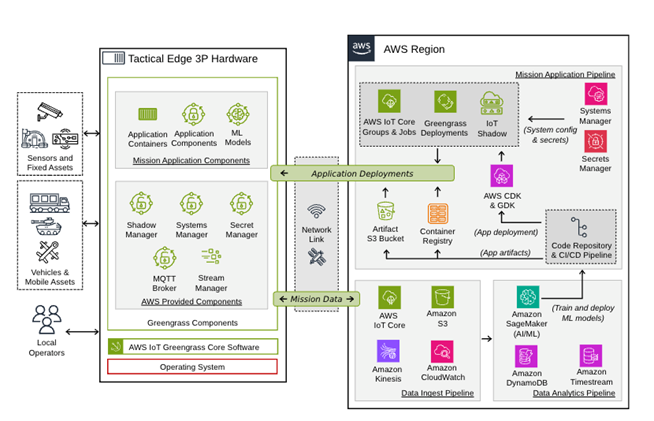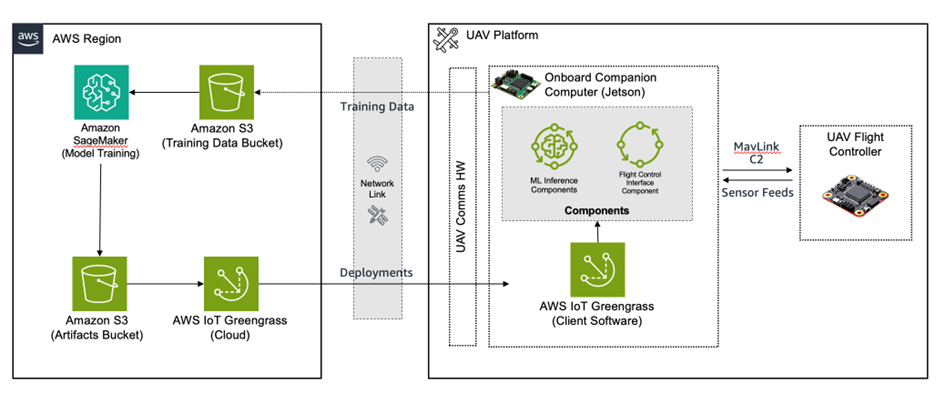AWS Public Sector Blog
Enabling the mission autonomy flywheel: The AWS four-phase approach to defense innovation
Defense organizations are rapidly embracing autonomous unmanned/uncrewed systems to enhance operational capabilities across all domains. This blog introduces the Amazon Web Services (AWS) comprehensive mission autonomy data flywheel framework, comprising four integrated phases: pre-deployment, deployment, operations, and post-mission analysis. Through detailed reference architectures, we demonstrate how each phase generates and utilizes data to create a continuous improvement cycle for autonomous unmanned/uncrewed systems.
In this post, you will learn how AWS technologies support the entire autonomous system lifecycle—including Unmanned Aerial System (UAS), Unmanned Underwater Vehicle (UUV), Unmanned Surface Vehicle (USV), and Unmanned Ground Vehicle (UGV) variations—from AI-powered design and virtual prototyping in pre-deployment, to edge computing through services like AWS IoT Core and AWS IoT Greengrass and related solution guidance like Tactical Edge Application Deployment on AWS and Cloud Edge Global Access (CEGA) during deployment, through real-time mission operations, and finally to post-mission evolution using secure over-the-air updates and predictive maintenance.
This framework shows how defense partners use AWS services to create secure, scalable environments that support concurrent development across classified domains while maintaining operational readiness. By breaking down traditional data silos and enabling continuous feedback loops, the mission autonomy data flywheel serves as a force multiplier for strategic defense capabilities.
Whether you’re developing new autonomous unmanned/uncrewed systems or enhancing existing platforms, this blog provides practical insights into implementing a comprehensive, data-driven approach to autonomous operations. Join us as we explore how AWS is transforming defense innovation through integrated reference architectures and proven implementation patterns.
Understanding the mission autonomy data flywheel
At AWS, we’ve identified four critical phases that create a continuous improvement cycle for autonomous unmanned/uncrewed systems. Each phase generates valuable data that enhances the others, creating a powerful flywheel effect that accelerates innovation while improving operational capabilities.
Pre-deployment: Igniting innovation through digital engineering
The journey to autonomous unmanned/uncrewed systems excellence begins with our pre-deployment phase, where AWS technologies are transforming how these systems are conceived and developed. At its core, this transformation is driven by digital engineering—the strategic deployment of information technologies and computational infrastructure that enables sophisticated workflows during the design, manufacturing, and operation of complex equipment.
Digital engineering creates a powerful foundation through three interconnected elements: digital threads, digital design, and digital twins. Digital threads provide the infrastructure that enables seamless data sharing across tools and organizations. Digital design integrates disparate tools and processes for system development, while digital twins create living digital representations of physical systems that continuously update to reflect real-world conditions.
By combining these digital engineering capabilities with advanced AI/ML and secure cloud infrastructure, we’re revolutionizing concept development and design automation for autonomous unmanned/uncrewed systems. Engineers can now create virtual prototypes in high-fidelity simulations, dramatically reducing development time while improving system reliability. The cloud serves as the key enabler, offering scalable resources, secure collaboration tools, and virtually unlimited storage to support these complex workflows.
Defense partners are leveraging AWS services to create comprehensive digital engineering environments that support concurrent development across classified domains. This automated design process feeds directly into deployment operations, providing valuable insights that enhance real-world performance. Through the integration of digital engineering principles with autonomous unmanned/uncrewed systems development, organizations can achieve improved delivery timelines, cost performance, and quality while maintaining the highest security standards.
This transformation demonstrates how each phase reinforces the others—from initial design through deployment and operations. Data flows seamlessly between stages, creating a continuous feedback loop that drives innovation and excellence throughout the entire system lifecycle.
Deployment: Dominate autonomous operations with AWS
A major issue we see customers face when fielding autonomous unmanned/uncrewed systems is the ability to securely deploy and update autonomous unmanned/uncrewed systems at scale. The robust edge computing and Internet of Things (IoT) capabilities of AWS and our experience across industries like automotive and oil and gas, provides a critical foundation for building comprehensive autonomy deployment solutions that take the innovated capabilities battlefield at scale. Through services like AWS IoT Core and AWS IoT Greengrass and related solution guidance like Tactical Edge Application Deployment on AWS and Cloud Edge Global Access (CEGA), we enable secure, low-latency operations at the tactical edge. Our reference architecture showcases how continuous integration/continuous deployment (CI/CD) pipelines ensure secure, rapid updates to autonomous unmanned/uncrewed systems.
The deployment phase generates critical data about system performance and operational challenges. This information flows back through our AI/ML pipelines, enabling faster issue identification and improving target processing accuracy. We’ll demonstrate how defense partners use this architecture to maintain security while accelerating deployment cycles.
Operations: Unifying the battlefield
In the operations phase, the global infrastructure and CEGA capabilities of AWS provide the low-latency networking essential for autonomous operations. Our reference architecture reveals how AI/ML decision support systems create a common operating picture across domains, breaking down traditional data silos.
This improved data visibility drives better mission performance while generating valuable usage data that flows back to improve platform design and mission planning. In subsequent blogs in this series, we’ll explore real-world examples of how this operational data enhances autonomous capabilities across air, land, sea, space, and cyber domains.
Post-mission: Continuous evolution
The flywheel of autonomous system evolution reaches its full potential in our post-mission phase, where AWS enables comprehensive system adaptation and improvement through three key capabilities: secure over-the-air updates, AI/ML model retraining, and predictive maintenance.
Secure over-the-air updates in DDIL environments: AWS has developed sophisticated patterns for managing autonomous vehicle platforms in Denied, Disrupted, Intermittent, and Limited (DDIL) environments. Our reference architecture demonstrates how defense organizations can securely deploy updates to these platforms —from autonomous control software to mission-specific ML models—while maintaining system integrity. Using AWS IoT Core and AWS IoT Greengrass as a foundation, organizations can build flexible deployment architectures that adapt to various operational scenarios:
- Direct cloud-to-vehicle updates for rapid development and testing
- Homogeneous fleet management through ruggedized gateway devices for forward operating bases
- Heterogeneous system management for diverse autonomous platforms operating in dynamic environments
AI/ML model retraining and evolution: The post-mission phase enables continuous improvement through automated model retraining using operational data. Amazon SageMaker AI provides a fully managed platform where defense organizations can quickly retrain and deploy updated models based on real-world mission data. This creates a powerful feedback loop where each operation improves system performance for future missions.
AWS enables sophisticated predictive maintenance capabilities that dramatically improve operational readiness. Organizations can:
- Generate digital twins of physical assets to predict maintenance needs
- Apply machine learning algorithms to IoT data for real-time health monitoring
- Deploy edge computing capabilities for local analysis in disconnected environments
This continuous improvement cycle serves as a force multiplier for strategic assets, ensuring autonomous unmanned/uncrewed systems evolve to meet emerging threats while maintaining peak operational readiness. The integration of secure OTA updates, model retraining, and predictive maintenance creates a robust framework for managing autonomous unmanned/uncrewed systems throughout their operational lifecycle.
The power of integration
What makes this approach truly transformative is how each phase reinforces the others. Data from operational deployments improves design processes. Enhanced designs lead to better deployment outcomes. Improved deployments generate more valuable operational data. And post-mission analysis drives continuous evolution across the entire lifecycle.

Figure 6. Connected autonomous unmanned systems, enabling seamless data transfer, advanced analytics, and innovative capabilities that scale across diverse applications and environments
These interconnected phases create a secure, scalable foundation for autonomous operations through integrated AWS services. By leveraging comprehensive pre-deployment architecture and maintaining rigorous security standards throughout, organizations can accelerate innovation while ensuring mission success.
Whether you’re developing new autonomous capabilities or enhancing existing systems, AWS provides the tools and infrastructure needed to transform defense operations. Our solutions empower teams to design, deploy, and continuously improve autonomous unmanned/uncrewed systems with confidence.
AWS continues to reshape autonomous systems for its defense customers through mission innovation initiatives at the tactical edge and in the AWS Cloud. For more information on AWS’s role in defense modernization and autonomous systems, visit our Cloud Computing for U.S. Defense and our Tactical Edge webpages.
To learn more about how AWS is enabling mission autonomy at scale, check out these recent blog posts:
- “Shield AI and AWS collaborate to deliver mission autonomy at fleet scale“
- “AWS demonstrates resilient and secure edge-to-cloud at Department of Defense exercise“
For more information on autonomous systems and the mission autonomy data flywheel, please email your AWS account team. Watch for upcoming blogs in this series exploring other aspects of autonomy in defense applications.
